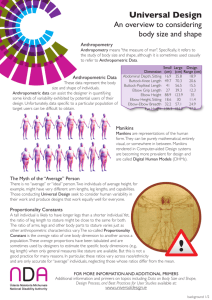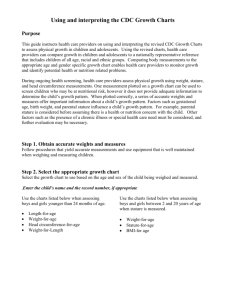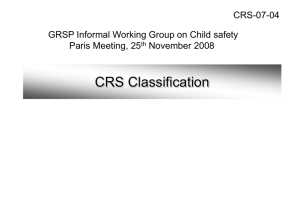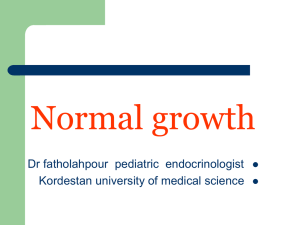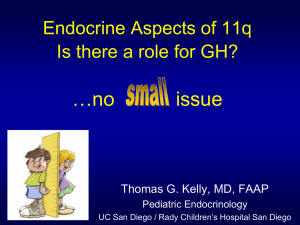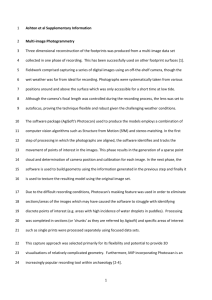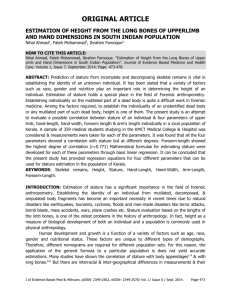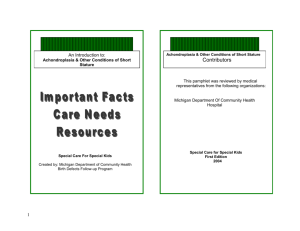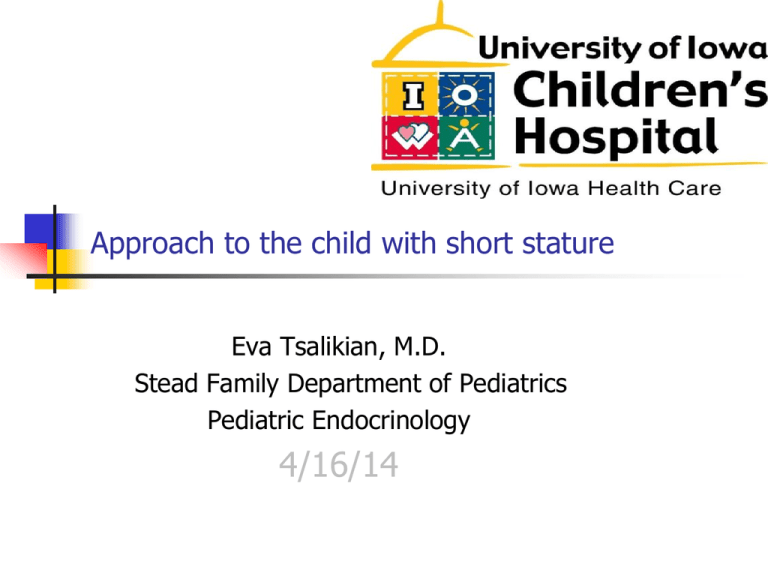
Approach to the child with short stature
Eva Tsalikian, M.D.
Stead Family Department of Pediatrics
Pediatric Endocrinology
4/16/14
Objectives
Short stature
a. General
b. Familial
c. Constitutional growth delay
d. Growth hormone deficiency
Names associated with delayed growth
Intrauterine growth retardation
Failure to thrive
Short stature
Growth and pubertal delay
Times of growth
Intrauterine growth
growth in Infancy
toddlers and preschool children
childhood - preadolescents
puberty- adolescents
adults
Prenatal and Postnatal growth velocity
Birth
10
8
Crown- 6
Heel
length
4
Velocity
(cm/4wk) 2
2
20
18
0
10
20
30
40
16
Postmenstrual age (wk)
14
12
10
8
6
Age (yr)
0
2
4
6
8
10
12
14
16
18
4
2
0
Height
Velocity
(cm/yr)
Diagnostic Evaluation of short stature
HISTORY
birth weight and length
growth pattern to date and previous
records
family heights
Parental heights
Midparental height calculation
Father’s height- 5 inches + mother’s height
2
Mother’s height + 5 inches + Father’s height
2
Midparental height Target:
Midparental height + 2SD(2inches)
Diagnostic evaluation of short
stature
PHYSICAL EXAM
accurate measurements
facies, body proportions
body fat distribution
pubertal staging
Height
measurement
ages 2-18yrs
Growth velocity
Tanner I Breast Development
Tanner II Breast Development
Female Genitalia
Tanner Staging -- Boys
Male Genitalia
Diagnostic evaluation (continued)
LABORATORY TESTS : general screening tests
(CBC & differential, chemistry panel, ESR)
RADIOGRAPHIC EVALUATION (bone age)
HEIGHT PREDICTION
from parental heights
from bone age
Bone Age
9 years
Bone Age
14 years
SHORT STATURE
Common complain
Symptom not a disease
Important to differentiate
Genetic/familial
Normal variant
Constitutional delay of growth
Proportionate
Pathologic short stature
Disproportionate
SHORT STATURE
NORMAL VARIANTS
Familial short stature
Family history of short stature
Normal growth velocity
Normal bone age
Constitutional delay of growth and
puberty
Family history of similar growth
pattern but average to tall final height
Low normal growth velocity
Delayed bone age
Growth
patterns
SHORT STATURE
PATHOLOGIC
Disproportionate
Uncommon, mostly due to skeletal
dysplasias:
achondroplasia or
dyschondroplasia
hypophosphatemic rickets
Proportionate Short stature
Most common, etiology prenatal or postnatal
Growth chart for children with
Achondroplasia
Proportionate Short Stature:
Etiology
Prenatal disorders
Intrauterine growth retardation
Dysmorphic syndromes
Chromosomal anomalies
Turner
syndrome
growth chart
PROPORTIONATE SHORT STATURE:
Etiology
Postnatal disorders
Undernutrition
Psychosocial dwarfism
Chronic diseases
Drugs
Hormones
Undernutrition and short stature
Low caloric intake
famine-feeding problems
Celiac Disease
Crohn’s disease
Growth pattern of a child with
psychosocial dwarfism
Hormonal disturbances
responsible for short stature
Hypothyroidism
Congenital/Acquired
Hypercortisolism
Cushing disease/ syndrome
Growth hormone deficiency
Sex steroids/Pubertal delay
HYPOTHYROIDISM
97%
26 months old boy
50%
3%
PE: Child small for age,
Proportionate,
no abnormal features,
wears glasses, rest of
exam WNL
Prevalence of growth hormone
deficiency: Utah Growth Study
114,881 children studied
GHD: height >2 SD below mean,
growth rate<5 cm/yr,
delayed bone maturation,
peak GH<10ng/mL
16 new cases identified
Prevalence 1:3480
Lindsay R. J. Pediatr 1994;125:29-35
Growth hormone deficiency
1 in 4000 children, 1% of “short”
children
Clinical characteristics
-short stature
-chubby face, truncal obesity
-delayed skeletal maturation
-high-pitched voice
Etiology: idiopathic vs organic
Growth Hormone Deficiency:
Diagnosis
No “gold standard” exists
-Short stature, slow growth,
compatible physique
-Low IGF-I, IGF BP-3
-insufficient rise in serum GH following
provocative stimuli
-Deficiencies of other pituitary hormones
Take Home Message
Short stature is a symptom not a disease
Etiology could be normal variant or
pathologic
Careful and specific H/P and laboratory
testing will guide you to the diagnosis and
appropriate management
Growth rate determination and accurate
measurements important


